
The Technical University of Nova Scotia (TUNS) was a Canadian university located in Halifax, Nova Scotia.

John Fitzwilliam Stairs, also known as John Fitz William Stairs was an entrepreneur and statesman, born in Halifax, Nova Scotia, a member of the prominent Stairs family of merchants and shippers founded by William Machin Stairs (1789–1865) that included the Victorian era explorer, William Grant Stairs.

The Bank of Nova Scotia, operating as Scotiabank, is a Canadian multinational banking and financial services company headquartered in Toronto, Ontario. One of Canada's Big Five banks, it is the third-largest Canadian bank by deposits and market capitalization. It serves more than 25 million customers around the world and offers a range of products and services including personal and commercial banking, wealth management, corporate and investment banking. With more than 92,001 employees and assets of Can$1,136 billion, Scotiabank trades on the Toronto and New York exchanges. The Scotiabank swift code is NOSCCATT and the institution number is 002.

Joseph Howe was a Nova Scotian journalist, politician, public servant, and poet. Howe is often ranked as one of Nova Scotia's most admired politicians and his considerable skills as a journalist and writer have made him a provincial legend.

Royal Bank of Canada is a Canadian multinational financial services company and the largest bank in Canada by market capitalization. The bank serves over 20 million clients and has more than 100,000 employees worldwide. Founded in 1864 in Halifax, Nova Scotia, it maintains its corporate headquarters in Toronto and its head office in Montreal. RBC's institution number is 003. In November 2017, RBC was added to the Financial Stability Board's list of global systemically important banks.

Camp Hill Cemetery is a cemetery within Halifax, Nova Scotia, Canada. It is located on Camp Hill, adjacent to Robie Street.
William Machin Stairs, was a merchant, a banker, and a statesman. He was born and died in Halifax, Nova Scotia, Canada.
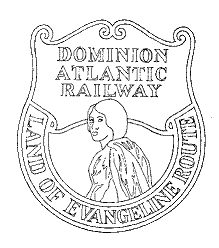
The Dominion Atlantic Railway was a historic railway which operated in the western part of Nova Scotia in Canada, primarily through an agricultural district known as the Annapolis Valley.
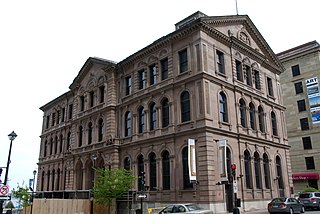
The Art Gallery of Nova Scotia (AGNS) is a public provincial art museum based in Halifax, Nova Scotia, Canada. The art museum's primary building complex is located in downtown Halifax and takes up approximately 6,200 square metres (67,000 sq ft) of space. The museum complex comprises the former Dominion building and two floors of the adjacent Provincial building.
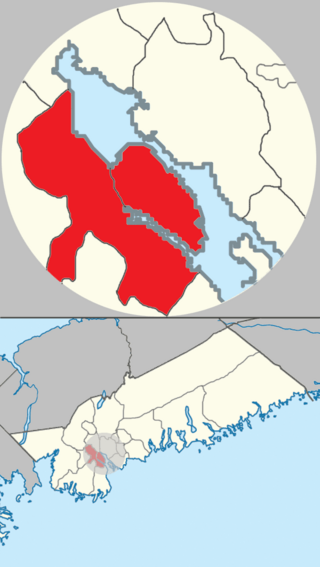
The community of Halifax, Nova Scotia was created on 1 April 1996, when the City of Dartmouth, the City of Halifax, the Town of Bedford, and the County of Halifax amalgamated and formed the Halifax Regional Municipality. The former City of Halifax was dissolved, and transformed into the Community of Halifax within the municipality.

The Maritime Life Assurance Company was a Canadian insurance company based in Halifax, Nova Scotia, Canada. It was founded in 1922 and in 2004 it became fully integrated with Manulife Financial, with the Maritime Life brand being retired. In 2004 it had 2700 employees.
William Black, C.M. is a Canadian business leader.
Sir Edward Kenny, was a Canadian politician and businessman. He co-founded the Union and Merchants' banks and served as Mayor of Halifax. He was a Conservative senator from 1867 to 1876.
Royal Securities Corporation Limited was a stock brokerage firm founded in Halifax, Nova Scotia, Canada in early 1903 by John F. Stairs, its first president. The company was the first brokerage firm to be opened east of Montreal, Quebec, the then financial center of Canada.
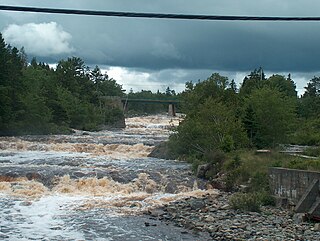
Sheet Harbour is a rural community in Nova Scotia, Canada. It is located in the eastern reaches of the Halifax Regional Municipality, approximately 117 km (73 mi) northeast of the central urban area of the municipality, concentrated on Downtown Halifax and Dartmouth. The community is located along the Marine Drive scenic route on Trunk 7 at its junctions with Route 224 and Route 374. Surrounding the branched harbour which its name is derived from, the community has a population of about 800 and its respective census tract, containing sizable amounts of land around the community, has a population of 3,478 as of the 2011 Census. Two rivers, West River and East River, flow through the community and into the Northwest and Northeast Arms of the harbour respectively. The coastline of the community is heavily eroded and the region in which the community is located has an abundance of lakes. The region has a humid continental climate, congruent with the majority of Nova Scotia, and the ocean significantly influences the temperature.

William Lawson was a Nova Scotian businessman, office holder, justice of the peace, and politician. He was born in Halifax, Nova Scotia, and was the son of John Lawson and Sarah Shatford.

The history of Nova Scotia covers a period from thousands of years ago to the present day. Prior to European colonization, the lands encompassing present-day Nova Scotia were inhabited by the Mi'kmaq people. During the first 150 years of European settlement, the region was claimed by France and a colony formed, primarily made up of Catholic Acadians and Mi'kmaq. This time period involved six wars in which the Mi'kmaq along with the French and some Acadians resisted the British invasion of the region: the French and Indian Wars, Father Rale's War and Father Le Loutre's War. During Father Le Loutre's War, the capital was moved from Annapolis Royal, Nova Scotia, to the newly established Halifax, Nova Scotia (1749). The warfare ended with the Burying the Hatchet ceremony (1761). After the colonial wars, New England Planters and Foreign Protestants immigrated to Nova Scotia. After the American Revolution, Loyalists immigrated to the colony. During the nineteenth century, Nova Scotia became self-governing in 1848 and joined the Canadian Confederation in 1867.
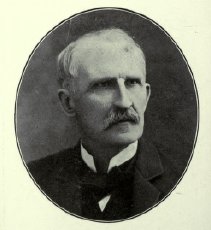
William Roche was a Canadian politician and merchant.
Denis Stairs OBE, B.Eng. was a Canadian engineer and businessman. He was born in Halifax, Nova Scotia, the son of George Stairs, a founding partner and president of Royal Securities Corporation. A graduate of Dalhousie University, Denis Stairs studied at MIT then as a director of Royal Securities he became associated with entrepreneur and press baron Sir Max Aitken and Izaak W. Killam. In 1922, he relocated to Montreal, Quebec, where he worked as an assistant engineer for Killam's Montreal Engineering Company, Ltd., rising to vice-president and eventually chairman of the board of directors.

Nova Scotia is a Canadian province located in Canada's Maritimes. The region was initially occupied by Mi'kmaq. The colonial history of Nova Scotia includes the present-day Maritime Provinces and the northern part of Maine, all of which were at one time part of Nova Scotia. In 1763, Cape Breton Island and St. John's Island became part of Nova Scotia. In 1769, St. John's Island became a separate colony. Nova Scotia included present-day New Brunswick until that province was established in 1784. During the first 150 years of European settlement, the colony was primarily made up of Catholic Acadians, Maliseet, and Mi'kmaq. During the last 75 years of this time period, there were six colonial wars that took place in Nova Scotia. After agreeing to several peace treaties, the long period of warfare ended with the Halifax Treaties (1761) and two years later, when the British defeated the French in North America (1763). During those wars, the Acadians, Mi'kmaq and Maliseet from the region fought to protect the border of Acadia from New England. They fought the war on two fronts: the southern border of Acadia, which New France defined as the Kennebec River in southern Maine, and in Nova Scotia, which involved preventing New Englanders from taking the capital of Acadia, Port Royal and establishing themselves at Canso.














